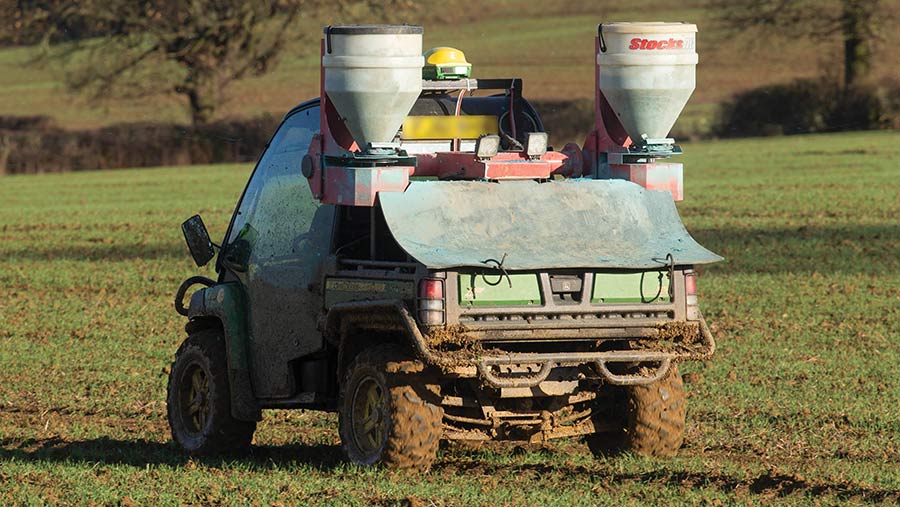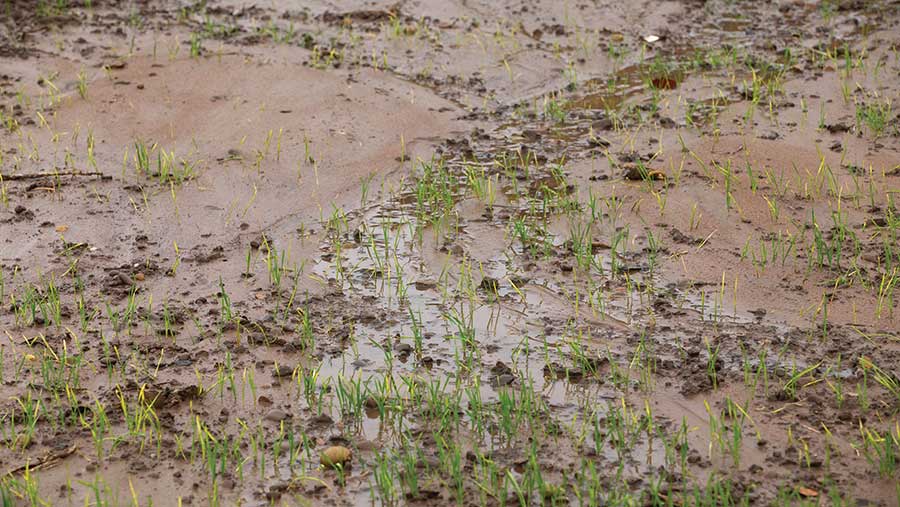Crop Watch: Babet’s rain holds up last of autumn drilling
 © Tim Scrivener
© Tim Scrivener Wet weather is disrupting the end of the autumn drilling season, with some growers struggling to get the last of their heavy blackgrass-infested land sown.
Slugs remain a big problem, aphids are evident in cereal crops, while post-emergence herbicide applications are being assessed, and although the rain has helped many oilseed rape crops, phoma disease is starting to be seen.
See also: Why blackgrass is so bad in 2023 and what to do about it
North
Conor Campbell
Hutchinsons (Northumberland)
This certainly has been a testing and trying autumn for many in the county. I reported last month that heavier rainfall in the south of Northumberland had impeded progress. But with a small window of opportunity, it is amazing how much can be done.
Many worked extremely hard to get as much in the ground as possible before the rain made its return. While we had a tremendous amount of rain thanks to Storm Babet, on already wet land, I must admit the images coming out of Scotland were shocking, with some areas reporting six or seven inches of rain.
I can’t decide if blaming the fact that the rain came from a different direction is laughable or insulting. I hope those in the worst affected areas are beginning to rebuild.
Despite the wet weather, the slug pressure remains, as many try to keep them away from newly emerged crops. Those in the north of the county had managed to apply residual chemistry in good time, which will help greatly in the spring with grassweed control.
The focus was on treating barleys for troublesome grassweeds, where spring options do not exist. It would be great if we had the opportunity to cover them, where we haven’t been able to do so, before Christmas.
Fertiliser
With crops being further behind than normal heading into the winter, early nitrogen in the spring could be important. Therefore, having stock in the shed in time for February may be a sensible move to ensure these crops can be fed and pushed on as soon as possible.
We will be waiting for the colder weather and hard frosts before applying our propyzamide products to oilseed rape. Many will be waiting to assess the viability of their crops, but will also need ground frosts to travel in many places.
Spring seed demand will be high. The challenging season and harvest will have had a knock-on effect on seed quality so I would suggest covering your requirements early as these can always be adjusted nearer the time.
West
Antony Wade
Hillhampton Technical Services (Hereford/Shropshire)
I have to apologise about starting my piece again talking about the weather, but we in farming are so dependent and driven by the weather. The coverage in the media of flooding in many parts of the country also shows how it can affect the wider public as well.
Babet, the second named storm of the season, seemed to come out of the blue – or at least out of an early forecast for a settled week – and deposited around 80mm of rain over 48 hours. Not as much as some areas, but enough to cause some flash flooding and rivers to burst their banks.
This sudden change of forecast caused some urgent activity in harvesting of potatoes and maize to try to beat the rain. Whether the drilling that chased in after these was a wise decision is yet to be decided.
Most of the seed-beds created in these later harvested crops, especially potatoes, were less than ideal, with some headlands too wet to drill. After 80mm of rain they now resemble boggy, silty soup that is a challenge to walk across, and I fear we will have some over-imbibed seed that will just rot in the water-saturated soil.
Whether we will get any more wheat drilled after these, or re-drilled if we have to, will depend on getting a spell of dry, cold weather with some wind – which will probably mean a change of flow to cold and dry from the North.
Slugs
Late September or early October-drilled wheat has been challenged by a burgeoning slug population, with many crops having multiple slug pellet applications. But in some cases this has not saved crops, with pellets not lasting or not being effective enough to control the growing population.
Barley and oat crops have suffered less from slug damage, as is usual, but are in need of aphicide to try to minimise risk of barley yellow dwarf virus (BYDV) infections.
Oilseed rape crops that had a challenging start have grown well in the last four to six weeks, although a lot of fields have a variable plant population but are filling out and improving. The other challenge has been to convince growers that oilseed crops that have not been very pleasing to the eye since planting are worth keeping.
We have lost a few fields, but most have improved enough for us to start to commit to controlling broad-leaved weeds – although we are still awaiting some spray weather.
The rainfall we have had since drilling has meant phoma lesions have increased to above threshold levels, so a fungicide has been included, especially on clubroot-resistant varieties which are more susceptible to phoma.
Light leaf spot will be dealt with later in November, probably with planned propyzamide applications. Some crops may even need some growth regulation, which I didn’t think would be needed back in September.
South
Iain Richards
Agrii (Oxfordshire)
Thank heavens we didn’t delay more wheat drilling than strictly necessary. A 120mm drenching has added to our concerns over wetness at depth, creating a serious headache for heavier blackgrass ground and land after maize.
We may have escaped Storm Babet better than many further north, but getting the last 20% of our crop in will be a long slog and we now have concerns about a significant proportion of those heavy land crops that were waterlogged for two weeks immediately post-drilling.
A combination of the weather and heavyweight harvesting kit has made a good amount of soil lifting essential after maize this season. A low-disturbance Grange toolbar has been invaluable here. It has run particularly well in the wet, really helping infiltration while leaving a good weatherproof surface.
Now, it’s just a matter of waiting for everything to dry out enough, as it is with the heavy land cultivated lightly after harvest which we dare not move again if we don’t want to risk creating a pudding that will last all winter.
We still have plenty of time to get the wheat drilled up. But we also need seed-beds that will give the crop a decent start and allow the residuals to work without damaging it. So, once again, patience and the ability to seize every sowing opportunity are our watchwords.
If conditions don’t come right, it’s important we’ve done nothing to get in the way of setting up the land for the spring barley that will be going in instead.
Seed rate
Any wheat sowings from now on will be at a good 400 seeds/sq m to make up for the lack of tillering time, less-than-ideal seed-beds, the likelihood they can’t be rolled, and seed hollowing in the unbelievably high slug pressure season.
This pressure has really underlined the value of stubble-raking or the lightest of cultivations after OSR, rather than just direct drilling. It has made a huge difference to our slug pellet use, reminding us of tillage benefits that can easily be forgotten.
The 60% of our wheat that went in before mid-October is dealing with the deluge well. The early dryness meant its peri-emergence went onto more blackgrass than we’d like. However, once things got wetter this weed growth started looking decidedly sick.
With temperatures cooling down noticeably now, we have high hopes for the strong residual chemistry we used both here and on the 20% of crops just coming through.
The vast majority of our OSR is looking good too, although we’ve had some monster companion buckwheat growth – almost enough to be competitive. Thankfully, the first frosts have slowed this down.
While growing well within their protective canopies, many of our OSR crops are nowhere near as thick as they appear from the road. This will put the onus on good pigeon control, and perhaps a specialist November plant growth regulator rather than just prothioconazole to promote early branching.
Propyzamide remains a good way off, not least to give enough time for the canopies to open up.
East
Marion Self
AICC/Prime Agriculture (Suffolk)
It’s wet! Low-pressure weather systems continue to dominate, topping up October’s rainfall which in Suffolk already exceeds 170 mm.
Growers are anxious as the soil is now saturated and fragile. Some established crops are suffering, although as soils start to dry these effects should be transient. More concerning are the crops sown just ahead of the main rain event, some of which sit visibly wet after each rain. On inspection, most seeds have germinated and we hope that these crops will establish.

© Tim Scrivener
However, there are problem areas with less structured soil, such as heavily trafficked headlands or crops after roots that will now stand wet for longer periods. Or indeed where the soil has been washed away or dumped, and that seed is unlikely to be viable.
The full extent of this damage will be clear in about two weeks’ time. For now, we take one day at a time and seize any spray opportunities that allow us to catch up with outstanding BYDV and herbicide treatments.
Drilling will re-commence according to rainfall and soil type. Some heavy land will not be drilled until drier, cooler weather comes and, in some circumstances, especially where blackgrass pressure is high, planned wheat crops may sensibly be swapped to a spring cereal.
Herbicides
Cereal crops that were drilled but not sprayed with a pre-emergence should be treated with herbicide as soon as conditions allow travel, so long as you are confident these areas will not need redrilling.
Take care where sequential post-emergence herbicides are planned. These should only be applied when the crop has recovered and is not visibly under stress. In some instances, large, competitive volunteer bean populations should be controlled this autumn, if possible.
As soils begin to dry, slug activity will increase again, especially in wheat after rapeseed or where there is a lot of surface trash. Continue to inspect traps and monitor crops for seed hollowing and leaf grazing.
Treat problem areas as soon you are able to travel and there is a weather window long enough to allow control. Crops should be individually assessed for BYDV spray strategy and micronutrient (including manganese) requirements. Use the T-sum tools available to help guide timings, but pragmatism will also be required to take opportunity of spray windows.
Conditions for bean planting are also a concern although there is still plenty of time to sow these until the end of December. Some growers are reconsidering the planting method and will switch to broadcasting and turning them in with the plough, or changing to a spring break crop or cereal.
If beans are planted, be sure that pre-emergence herbicides can be applied promptly, as beans without them will most likely end up dirty with weeds.

